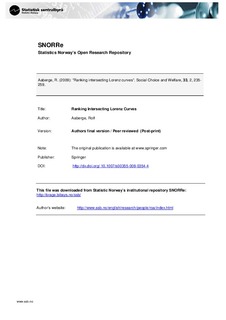| dc.contributor.author | Aaberge, Rolf | |
| dc.date.accessioned | 2011-11-29T16:05:51Z | |
| dc.date.available | 2011-11-29T16:05:51Z | |
| dc.date.issued | 2009 | |
| dc.identifier.citation | Social Choice and Welfare, 2009, Volume 33, Number 2, Pages 235-259 | no_NO |
| dc.identifier.issn | 1432-217x | |
| dc.identifier.uri | http://hdl.handle.net/11250/178136 | |
| dc.description | The original publication is available at www.springer.com | no_NO |
| dc.description.abstract | This paper is concerned with the problem of ranking Lorenz curves in situations where the Lorenz curves intersect and no unambiguous ranking can be attained without introducing weaker ranking criteria than first-degree Lorenz dominance. To deal with such situations two alternative sequences of nested dominance criteria between Lorenz curves are introduced. At the limit the systems of dominance criteria appear to depend solely on the income share of either the worst-off or the best-off income recipient. This result suggests two alternative strategies for increasing the number of Lorenz curves that can be strictly ordered; one that places more emphasis on changes that occur in the lower part of the income distribution and the other that places more emphasis on changes that occur in the upper part of the income distribution. Both strategies turn out to depart from the Gini coefficient; one requires higher degree of downside and the other higher degree of upside inequality aversion than what is exhibited by the Gini coefficient. Furthermore, it is demonstrated that the sequences of dominance criteria characterize two separate systems of nested subfamilies of inequality measures and thus provide a method for identifying the least restrictive social preferences required to reach an unambiguous ranking of a given set of Lorenz curves. Moreover, it is demonstrated that the introduction of successively more general transfer principles than the Pigou-Dalton principle of transfers forms a helpful basis for judging the normative significance of higher degrees of Lorenz dominance. The dominance results for Lorenz curves do also apply to generalized Lorenz curves and thus provide convenient characterizations of the corresponding social welfare orderings.
Keywords: The Lorenz curve, Lorenz dominance, partial orderings, the Gini coefficient, rank-dependent measures of inequality, generalized Gini families of inequality measures and general principles of transfers. | no_NO |
| dc.language.iso | eng | no_NO |
| dc.publisher | Springer | no_NO |
| dc.subject | Lorenz curves | no_NO |
| dc.subject | Gini coefficient | no_NO |
| dc.subject | Inequality measures | no_NO |
| dc.subject | Personal income | no_NO |
| dc.subject | Income | no_NO |
| dc.subject | Income distribution | no_NO |
| dc.subject | JEL classification: D31 | no_NO |
| dc.subject | JEL classification: D63 | no_NO |
| dc.subject | Scientific article | |
| dc.title | Ranking intersecting Lorenz curves | no_NO |
| dc.type | Journal article | no_NO |
| dc.type | Peer reviewed | no_NO |
| dc.subject.nsi | VDP::Social science: 200::Economics: 210::Economics: 212 | no_NO |
| dc.source.pagenumber | 235-259 | no_NO |
| dc.source.volume | Volume 33 | no_NO |
| dc.source.journal | Social Choice and Welfare | no_NO |
| dc.source.issue | Number 2 | no_NO |
| dc.identifier.doi | http://dx.doi.org/10.1007/s00355-008-0354-4 | |
